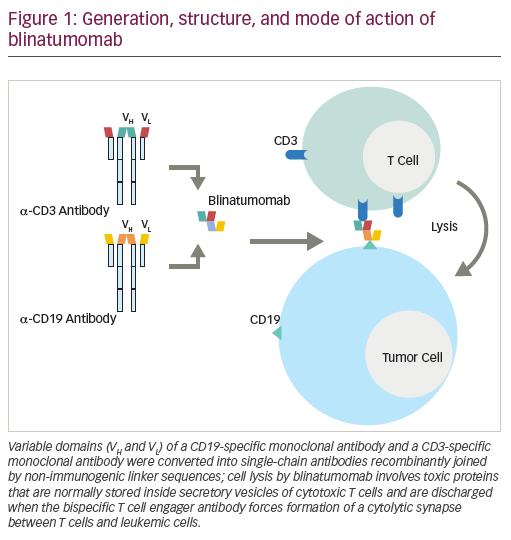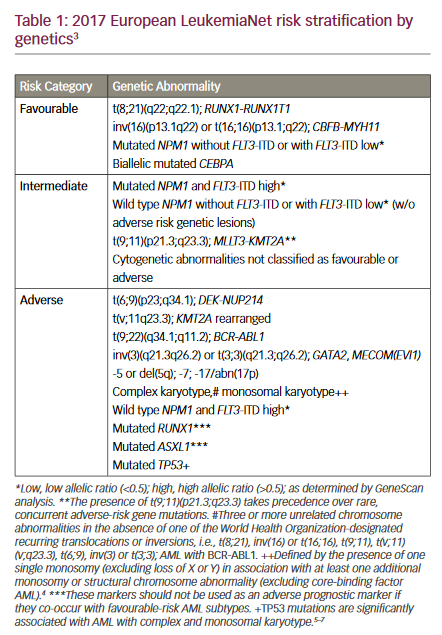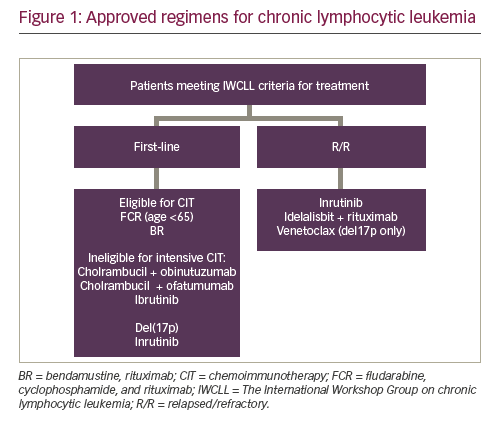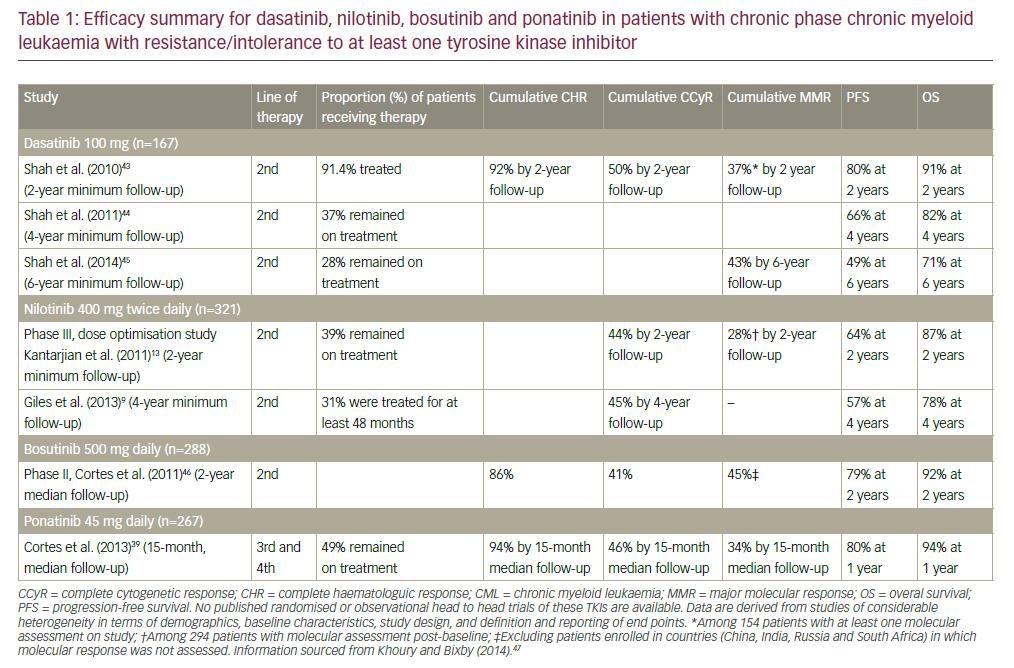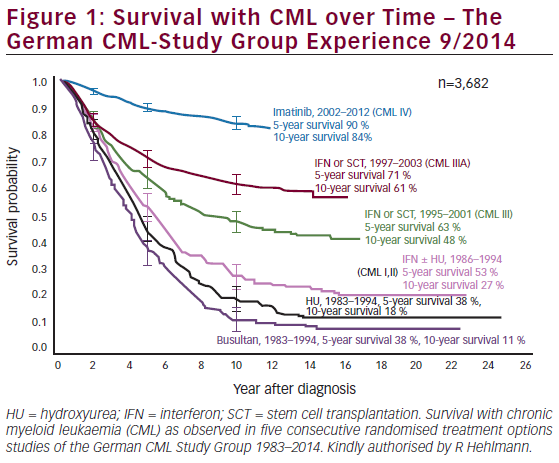However, it has become increasingly apparent that the clinical course of CLL is highly variable and in some patients not as benign as was previously thought. Thus, large clinical studies have demonstrated that nearly 40% of untreated patients with early-stage CLL will progress to the point of requiring therapy and over 20% will die of complications relating to the disease.2 The identification of a number of biological variables, including IgVH mutation status,3,4 CD38 expression,3,4 ZAP-70 expression5,6 and TP53 defects,7–9 has provided clinicians with valuable prognostic information. The question of whether pre-emptive therapy of patients with asymptomatic early-stage disease is of any benefit is currently being revisited using a more focused approach that targets patients at high risk of early progression.
With regard to patients who require treatment by conventional criteria, the traditional palliative approach has undergone considerable revision in the last few decades due to the introduction of more effective therapies that have the ability to induce much deeper and longer-lasting remissions than have hitherto been possible. Thus, there has been a shift towards aiming to prolong survival through maximal disease control. This has been made possible due to the incorporation of purine analogues, particularly fludarabine, in chemotherapy regimens,10 and the development of immunochemotherapy regimens.11,12
Although the utilisation of the purine analogue fludarabine has improved the treatment of CLL, not all patients respond, and some responders relapse within a disappointingly short time-frame due to the rapid regrowth of residual malignant cells.13,14 The prognosis for these patients has hitherto been poor owing to the lack of available therapeutic options. The introduction of immunotherapeutics in the form of the monoclonal antibodies alemtuzumab and rituximab has expanded the CLL armamentarium, providing more therapeutic options for such fludarabine-refractory patients and also offering the potential for further improving first-line therapy.12,15
The Evolution of CLL Therapy – From Chemotherapy to Immunochemotherapy
As more effective therapies have become available, treatment has begun to switch from alkylating agents to purine analogues and, more recently, to the inclusion of immunotherapies.The alkylating agent chlorambucil was originally the gold standard of treatment in patients with CLL. Although it is self-evident that chlorambucil prolongs life relative to no treatment in a patient who has life-threatening complications, single-agent or combination chemotherapy with alkylating agents is associated with low complete response (CR) rates.1,2 An additional problem associated with alkylators is a risk of secondary myelodysplasia or acute myeloid leukaemia, although this risk has also been reported for purine analogues and, especially, purine–alkylator combinations such as fludarabine plus chlorambucil.16–18 The publication of data from several randomised trials demonstrating the superiority of the purine analogue fludarabine as a single agent over chlorambucil, over cyclophosphamide, doxorubicin and prednisolone and over cyclophosphamide, doxorubicin, vincristine and prednisolone (CHOP) in previously untreated patients has led to a change in thinking about CLL therapy: each of these trials showed that fludarabine was associated with greater overall and complete remission and longer progression-free survival (PFS).13,19,20 Interestingly, the UK LRF CLL4 trial21 showed little advantage of fludarabine over chlorambucil, certainly in terms of PFS. This may have been due to the higher dose of chlorambucil used in the trial (70mg/m2 per cycle compared with the 40mg/m2 per course in the CALGB trial).13 None of the trials showed a significant advantage in overall survival (OS) for fludarabine, and patients treated with the purine analogue followed a continuous pattern of relapse.
Combination Chemotherapy with Fludarabine
The encouraging results of the randomised trials with single-agent fludarabine therapy led to investigations of the agent in combination regimens. Fludarabine plus cyclophosphamide (FC) in patients with CLL has been shown to produce >80% response rates in all patients not refractory to fludarabine at the start of therapy.22 Several recent phase III studies have indicated greater activity with FC compared with fludarabine alone for chemotherapy-naïve patients with CLL. In the German CLL4 study in previously untreated patients less than 65 years of age, FC therapy resulted in better overall response rates (ORRs) and PFS compared with fludarabine alone.23 However, after a follow-up period of 22 months, no difference in OS was observed. In the UK LRF CLL4 and US Intergroup E2997 trials in previously untreated patients with CLL, treatment with FC was associated with a significantly higher CR and ORR and superior PFS compared with single-agent therapy.21,24 However, again no significant difference in OS between patients given FC or fludarabine was observed. Nevertheless, the compelling evidence from these data is that FC provides a consistent benefit over fludarabine alone in terms of PFS.
Deletion or mutation of the TP53 gene at chromosome band 17p13, which encodes the p53 protein, is a strong predictor of short survival and resistance to chemotherapy.7,8 In the German CLL4 study, 17p deletion was observed in five of nine patients who did not respond to FC.23 Patients with 17p and 11q deletions in the US Intergroup E2997 study experienced reduced PFS, although cytogenetics, IgVH mutational status, CD38 expression and p53 mutational status did not affect CR and ORR.25 Preliminary analysis of the UK LRF CLL4 study indicates that 17p deletion and 11q deletion were associated with worse PFS and responses.26 The combination of fludarabine, cyclophosphamide and mitoxantrone (FCM) has also demonstrated efficacy in a phase II trial. The study by Bosch et al. in patients less than 65 years of age with newly diagnosed CLL requiring therapy showed that FCM treatment provided a CR of 64%, an ORR of 90% and median response duration of 37 months.27 No patients with 17p deletion detected by fluorescence in situ hybridisation (FISH) responded to treatment with FCM.
The Introduction of Targeted Therapies – The Rituximab Era
Rituximab, a chimaeric anti-CD20 monoclonal antibody, has transformed the treatment of certain B-cell malignancies such as diffuse large B-cell lymphoma (DLBCL) and follicular lymphoma (FL). However, as single-agent therapy the standard dose of rituximab has relatively limited efficacy in patients with CLL. Higher doses of rituximab or increased frequency or duration of therapy are required to elicit comparable responses to those reported for other indolent lymphoid cancers.28–31 The limited activity of single-agent rituximab in CLL may be due to low expression levels of CD20 on the CLL cells.32 Imunochemotherapy with Rituximab
In contrast to single-agent therapy, immunochemotherapy with rituximab has produced encouraging data. One of the most widely studied immunochemotherapy regimens thus far has been the combination of fludarabine, cyclophosphamide and rituximab (FCR). This regimen, pioneered by investigators from MD Anderson Cancer Center, has been shown to produce a high complete remission rate in both previously untreated and relapsed CLL patients. Keating et al. evaluated the efficacy of FCR in previously untreated patients with CLL requiring therapy in a phase II study. With a median of six cycles of FCR, OR and complete remission rates of 95 and 70%, respectively, were achieved.11 At a median follow-up of six years, OS was 77% and PFS was 51%. Eighty-two per cent of patients in CR achieved minimal residual disease (MRD)-negative status.33 However, it should be noted that MRD in the study was measured by the less sensitive two-colour flow cytometry and not the recently published, internationally standardised high-sensitivity flow cytometry technique.34 In previously treated patients with relapsed or refractory CLL, FCR treatment was associated with 25% CR, and nodular partial response (PR) and PR were achieved in 16 and 32% of patients, respectively. The OR rate was 73%, and molecular remissions were seen in one-third of patients achieving CR.12
Rituximab has also been investigated in other immunochemotherapy regimens, including with fludarabine alone35 and with pentostatin plus cyclophosphamide.36,37 These trials also produced encouraging data, although the FCR combination has produced the strongest results to date. Clinical trials comparing FC, the most effective chemotherapeutic regimen in terms of CR in phase III trials, with FCR are ongoing. The German CLL Study Group (GCLLSG) CLL8 phase III study, which was evaluating FC versus FCR as first-line treatment, closed to recruitment ahead of schedule as the primary end-point (PFS advantage) was met. Full results of the CLL8 study are expected to be presented at the American Society of Haematology (ASH) annual meeting in December 2008. The results of a randomised, open-label phase III study comparing the effect of FC versus FCR (REACH) for second-line treatment are also anticipated.
Alemtuzumab
Alemtuzumab is a monoclonal antibody that targets CD52. Since the CD52 antigen is highly expressed on CLL B cells and normal T and B lymphocytes,38 alemtuzumab may offer advantages over rituximab in CLL. It has been evaluated for first-line use alone, in combination with immunochemotherapy, as salvage therapy and as consolidation therapy.39–45
Defining a Role for Alemtuzumab
Alemtuzumab’s initial European indication was for the treatment of patients with B-cell CLL (B-CLL) who have been treated with alkylating agents and who have failed to achieve CR or PR or achieved only a short remission (<6 months) following fludarabine therapy. This indication was recently expanded to include first-line treatment of patients with B-CLL for whom fludarabine combination chemotherapy is not appropriate. In the US, alemtuzumab was initially approved under accelerated approval regulations for treatment of B-CLL in patients who had been treated with alkylating agents and who had failed fludarabine therapy. Recently, the US labelling was expanded and alemtuzumab was granted regulatory approval as a single agent for the treatment of B-CLL in the first-line setting.
Alemtuzumab in Chemotherapy-refractory CLL
Data from several small studies have demonstrated the activity of alemtuzumab monotherapy in relapsed/refractory CLL.15,39,42,45–47 In the largest of these studies, 93 patients who had received ≤7 previous therapies, including at least one alkylating agent-based regimen, and who had failed fludarabine treatment were treated with alemtuzumab for a maximum of 12 weeks.42 Alemtuzumab monotherapy produced an ORR of 33%, with 2% CR and 31% PR. The median time to response was 1.5 months and the median duration of response was 8.7 months. These and other studies noted that alemtuzumab was highly active in both blood and bone marrow, but had a lesser effect in the presence of bulky lymphadenopathy.15,40,42,48 Alemtuzumab as First-line Therapy
The CAM307 study compared chlorambucil with intravenous alemtuzumab as front-line therapy for CLL.41 This international, multicentre, open-label phase III trial randomised 297 patients to receive either alemtuzumab at the standard dose of 30mg intravenously three times per week for up to 12 weeks or chlorambucil 40mg/m2 once every 28 days for up to 12 cycles. In the alemtuzumab group OR was 83% compared with 55% for the chlorambucil group. Overall median PFS for the alemtuzumab group was
14.6 months compared with 11.7 months for the chlorambucil arm. No differences in OS were observed. In patients who had the cytogenetic deletion of 17p (p53), alemtuzumab therapy was associated with a threefold increase in OR compared with chlorambucil. Of the biological prognostic factors identified to date, deletion or mutation of the TP53 gene at chromosome band 17p13 is one of the most ominous predictors of survival and is associated with resistance to conventional chemotherapy.8,9 In an earlier series in the second-line setting by Lozanski et al.,43 alemtuzumab was shown to be effective in CLL patients with p53 defects. These data are important as they identify alemtuzumab as one of the few agents with activity in this important sub-group of CLL patients who are refractory to chemotherapy. Sub-analysis of the CAM307 study also revealed that in patients with 13q and 11q deletion, alemtuzumab treatment resulted in statistically significantly superior responses compared with chlorambucil.
Maximal Disease Control in CLL
Notably, the study by Moreton et al.15 demonstrated that patients who achieved CR and who were also negative for MRD, as measured by four-colour flow cytometry, had a significantly prolonged PFS and OS. In this study, 91 CLL patients were treated with alemtuzumab for a median period of nine weeks, initially at 3mg daily with titration upwards through 10mg daily to 30mg three times weekly. The technique used to assess MRD in the study was very sensitive, detecting one CLL cell per 10,000 normal cells. MRD was reduced to below the threshold of detection in 20% of patients following alemtuzumab therapy. In those patients who achieved MRD negativity, OS was significantly prolonged, an observation that supports the contention that the achievement of MRD negativity is a desirable treatment end-point in CLL, irrespective of what first-line treatment is given.
The idea that further reduction of the tumour burden could be of clinical benefit was the rationale for the several studies involving alemtuzumab as consolidation therapy after fludarabine-based induction regimens. A small series conducted by O’Brien et al. showed that alemtuzumab at a reduced dose achieved additional significant responses in patients with residual disease after chemotherapy.48 Similar results were reported by Montillo and colleagues.49 In both studies an improvement in response was reported in approximately half of the patients treated with alemtuzumab consolidation therapy. Importantly, MRD negative status, as defined by negative polymerase chain reaction (PCR) with consensus IgH primers, was achieved in one-third of the patients.
The GCLLSG trial (CLL4B) is the only randomised study to date to evaluate alemtuzumab consolidation versus observation following first-line fludarabine or FC therapy. Although this trial was closed early due to an unacceptable rate of infectious disease complications (seven of the 11 patients receiving alemtuzumab had severe infections), data from the study showed a significant improvement in PFS for patients receiving alemtuzumab consolidation.44,50 The increased incidence in infectious toxicity between the German CLL Study Group experience and previous consolidation studies may have been related to the relatively short time interval between initial chemotherapy and alemtuzumab consolidation in the German CLL Study Group trial (median two months, compared with five months in the Montillo study). Early data from the phase II US Cancer and Leukemia Group B study CALGB 10101, which is examining a regimen of fludarabine and rituximab for six cycles followed by subcutaneous alemtuzumab for six weeks as consolidation therapy, reported six infection-related deaths.51 In this study, the median time interval between initial chemotherapy and alemtuzumab consolidation was four months. Further ongoing studies evaluating alemtuzumab consolidation therapy will help to answer questions on optimal timing and dosing of the agent in this setting.Immunochemotherapy with Alemtuzumab
Currently, there are limited data regarding immunochemotherapy with alemtuzumab, and several trials utilising alemtuzumab immunochemotherapeutic regimens are ongoing in the first-line setting. Not surprisingly, a number of studies are investigating the combination of the most effective chemotherapeutic agent with alemtuzumab. The combination of fludarabine and alemtuzumab has been investigated in a phase II trial in patients with relapsed CLL.52 The fludarabine and alemtuzumab combination administered in a four-weekly dosing protocol achieved an ORR of 83% (30/36 patients), with 30% CR and 53% PR. Importantly, 53% of evaluable patients were MRD-negative at three-month follow-up. The phase II UKCLL202 trial evaluated the combination of alemtuzumab and fludarabine (CamFlud) in fludarabine-refractory CLL patients. Subcutaneous alemtuzumab was given three times weekly for up to 24 weeks (median 18.8 weeks) depending on six-weekly marrow assessments or until maximum response. Non-responders after 12 weeks of alemtuzumab therapy then received fludarabine concurrently for three days every four weeks. Seventeen patients received alemtuzumab plus fludarabine: one patient achieved CR and two achieved PR.53
Future Directions
There is a growing body of evidence that alemtuzumab is effective in CLL. Alemtuzumab monotherapy has been shown to be effective in both first-line and refractory CLL. Alemtuzumab is associated with risk of toxicity, especially with bacterial and viral infections,54 although these infections appear to be manageable with standard therapies.41 Furthermore, while alemtuzumab is currently licensed for intravenous administration, evidence suggests that subcutaneous administration of alemtuzumab may reduce the incidence of non-haematological adverse events.40 A growing body of evidence also suggests that alemtuzumab may be useful as consolidation therapy and in immunochemotherapy regimens. The encouraging results seen thus far warrant larger randomised trials to confirm the effectiveness of alemtuzumab in these settings, as well as phase II studies to establish the optimal timing, dose and delivery of the drug. The activity of alemtuzumab in patients with 17p deletions resulting in dysfunction of the p53 pathway is also of clinical importance, especially with the increasing ability to stratify patients according to prognostic risk parameters such as genetic abnormalities. Thus, in CLL patients with p53 deletion who do not have bulky nodal disease, alemtuzumab may offer appropriate benefits when used as earlier therapy. Furthermore, glucocorticoids may also be useful agents in this setting, and the effectiveness of combined methylprednisolone and alemtuzumab (CAMPRED) is currently under investigation.55







